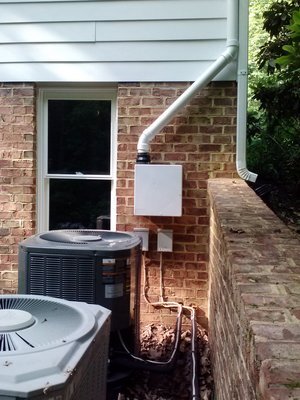Here's How We'll Mitigate Your Radon
This is our simplified approach to understand Radon mitigation, the parts of a system and how they vary.
Your basement floor is essentially a concrete slab, 4 to 6 inches deep, and Radon gas is trapped underneath the surface area of your house. It cannot rise unhindered into the air but accumulates and builds up pressure.
Radon reduction involves a lot of heavy drilling through concrete slabs and walls.
A hole is drilled into the slab of the house and a pipe inserted in order to continuously extract the air so that the Radon gas does not build up pressure. The pipe is then routed internally within the house, bypassing waterlines and heating tubes, or out to the exterior, and in both cases ending above the roof line, where the system emits the gas safely.
The Radon level determined during careful testing dictates the placement of the suction hole, the size of the pipes, and the type of fan required for the job.
The Radon professional has all the tools for this.
Once the routing of the system is designed, the building can begin...up,up and away!
The opening on top has a screen to prevent sqirrels, branches and leaves from dropping in. Some people paint the exterior pipe with the siding color to hide the white PVC.
Here is what the parts of a system look like, as well as a short review of the process.
There are many ways to route a Radon reduction system through the house or the garage. Going through closets inside the house is probably the smartest way to hide the system.
However, all closets in the house may not line up to accomplish that.







Crawl Spaces
Crawl spaces can cut a huge chunk out of your building budget, but create serious problems for Radon mitigation; they are difficult to tackle and seal properly.
Not all are so clean and easily accessible, like these here. Caulking and installing a membrane in a low crawlspace (where there is clay, gravel or dirt) is the toughest part of the mitigation.
Radon in Water
We test and install a special system that removes Radon from your water (well water, too). While the majority of Radon levels in the area are below action level, this is a growing issue. It's always a good idea to be safe and know what you're dealing with. Click below to see the testing and installation processes and how we can help!
Energy Recovery Ventilator
The ERV system improves the air quality in your home while simultaneously reducing the Radon level. It takes fresh air in from the outside and exhausts stale air (and Radon) from the house via a powerful fan that also adjusts cold air in the winter and hot air in the summer. Click below to find out more!
Sub-slab Mitigation
Many new homes and townhouses are slab-on-grade, that means there is no basement. Often we find a spot inside the house where we can hide a pipe and direct it into the attic and out through the roof.
If not, we go to the corner of the house and install from the outside. We drill through the foundation wall from outside and reach under the floor. That usually works very well and the rest is easy.
Testimonial
"Central Virginia Radon did a wonderful job installing our mitigation system. Wolfgang Hermann was very helpful in explaining his work. His primary concern, of course, was reducing our radon level but he also focused on installing our system in an aesthetically-pleasing way. In the end, Wolfgang significantly reduced our radon level to well below EPA standards and installed an unobtrusive and visually-pleasing system. We highly recommend his services."
- Tammy Purcell, Louisa, VA




